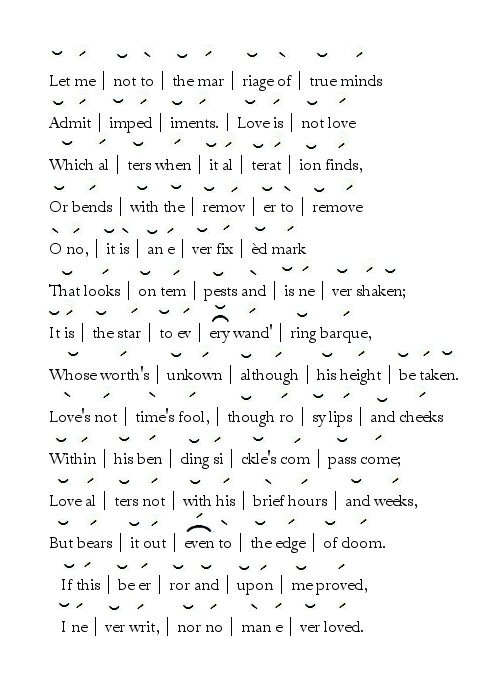

Poetry that does not follow any specific pattern of form, rhyme, or meter poetic devices – Two lines of rhymed verse in iambic pentameter generally used in epic poems tercet –Ī three-line poem or stanza in a poem quatrain –Ī poem or stanza of eight lines in a poem ottava rima–Ī poem or stanza of eight lines with a specific rhyme pattern: iambic pentameter with ab ab ab cc terza rima –Ī poem or stanza in three lines with the first and third line rhyming: aba bcb cdc and so on blank verse –Īn open-form of poetry that is presented as prose open form (free verse, vers libre) – Commonly used by Shakespeare in his sonnets common measure –Ī ballad stanza generally rhyming in alternating pairs couplet –Ī poem or stanza of two line heroic couplet –

Poetry which follows a pattern of sounds, rhyme, or meter iambic pentameter –Ī common type of pattern of sounds and rhythm used in poetry created by pairing ten syllables for each line into five pairs. Poetry has two forms: narrative which tells a story and lyric which expression an emotion or idea line –Ī line of poetry is what is written on one line not necessarily a sentence stanza –Ī group of lines generally completing an idea closed form (fixed form) – Use of language in non-everyday ways such as repetition of sounds and rhyme or focus on an observation or feeling using figures of speech and imagery and other devices to compress meaning resulting in more intense communication form (poetic form) – Non-prose use of words to express a feeling or idea usually associated with repetition of sounds, patterned sequences of words and/or lines, figurative language and other poetic devices, and has a highly focused purpose either to tell a story or express an emotion or idea poetry – This is the famous example of a blank verse, using unrhyming lines with iambic pentameter (ten syllables in a line and five are stressed).The use of language in day-to-day situations including business settings and which generally follows conventional practices such as grammatical rules non-poetic style of language text –Īny written body of words may be either prose or poetry poem – The force of those dire Arms? yet not for those He with his Thunder: and till then who knew Example #7: Paradise Lost (by John Milton)įrom what highth fal’n, so much the stronger provd In the first line, you can notice the use of caesura in the middle it breaks the monotony and creates a dramatic effect. In this example, the first two lines are using trochaic heptameter, while the final line is using dactylic tetrameter. Walcott has used mixed metrical pattern in this poem. L oosening the grip of their roots, till their hairy clods… Springs, the babble of swol len gul ches un der drenched ferns, Example #6: The Bounty (by Derek Walcott) The rhyme scheme of this poem is irregular and unpredictable, and in this stanza it is AAAB. This stressed syllable appears at the beginning and in the middle of the lines. Dactylic foot uses a stressed syllable followed by two unstressed syllables. This is a good example of dactylic dimeter with two feet in each line. Example #5: The Charge of the Light Brigade (by Alfred Lord Tennyson) The rhyme scheme of this stanza is ABCBB. The metrical pattern of this stanza is trochaic octameter in which eight stressed syllables are followed by eight unstressed syllables.

“ tis some visi ter,” I mu ttered, “ tapping at my chamber door. While I nodded, nea rly napping, suddenl y there came a tapping,Īs of someone gently rapping, rapping at my chamber door. Over many a quaint and cu rious vo l ume of forgot ten lore, Once up on a mid Night dreary, while I pondered, weak and weary, Example #4: The Raven (by Edgar Allan Poe) You can see the first, second and fourth lines have used iambic tetrameter, while the third line has used tetrameter.
DEFINE SCANSION IN POETRY FREE
However, there is no strict meter, as it is a free verse poem. Though first two lines rhyme in this example.


 0 kommentar(er)
0 kommentar(er)
